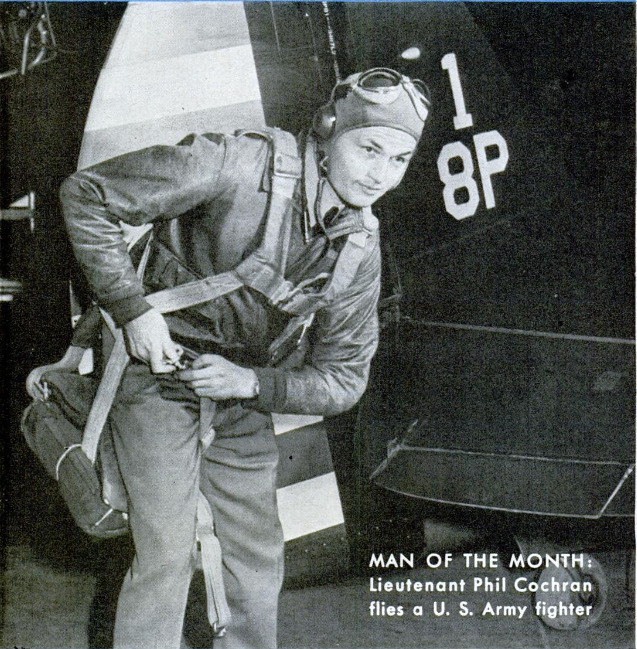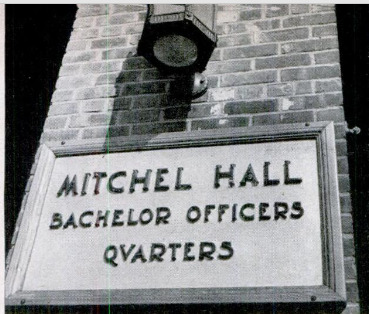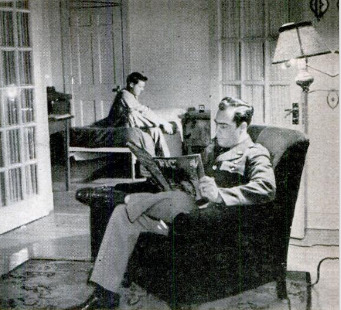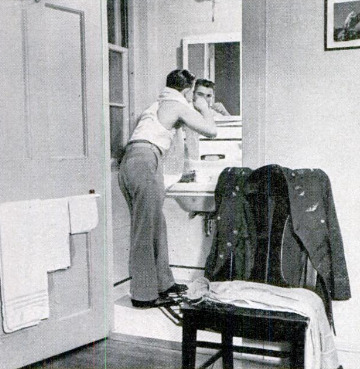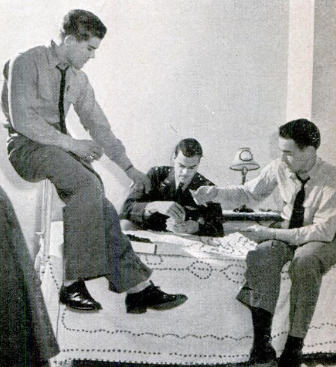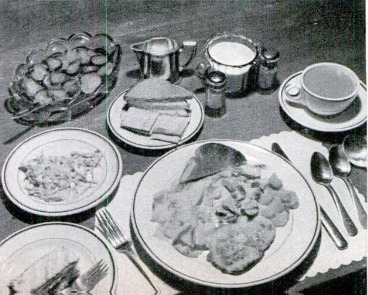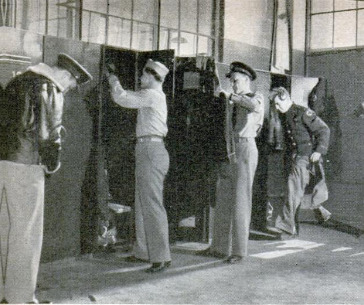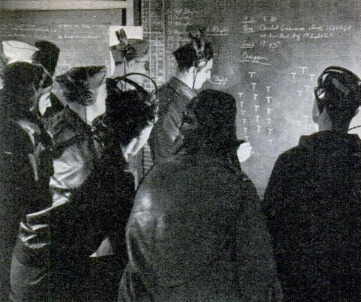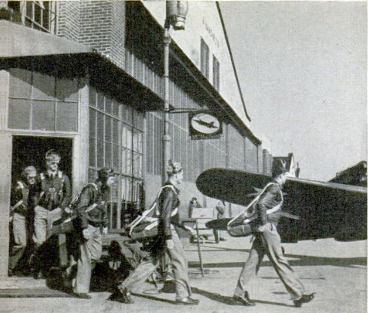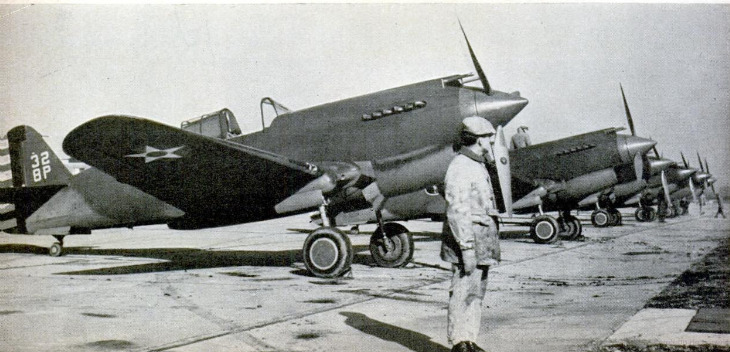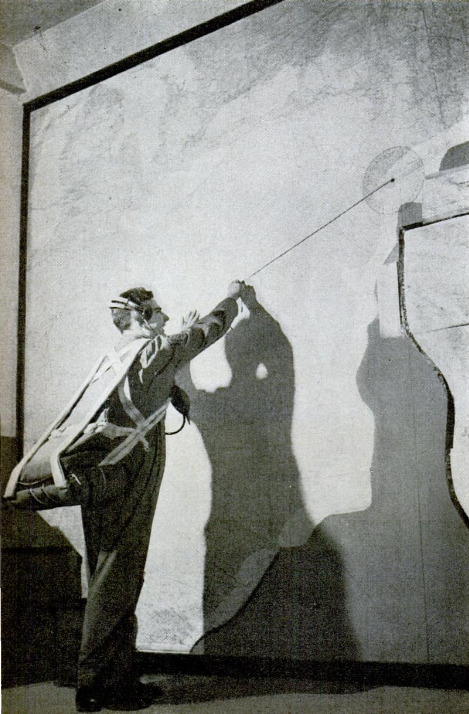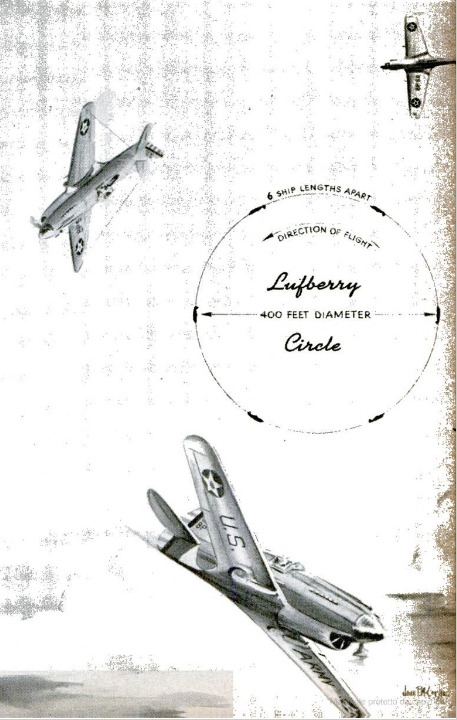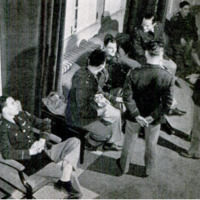-
Title (Dublin Core)
-
Pursuit pilot
-
Article Title and/or Image Caption (Dublin Core)
-
Title: Pursuit pilot
-
extracted text (Extract Text)
-
THE six little planes became visible
eis as a string of tiny dots, and
almost immediately were circling
around the field. They swung around in
their traffic pattern at 1,000 feet. Then the
leader dropped off, came down in a short,
tight spiral, sideslipping all the way to
lose altitude quickly. He set the fast Curtiss
P-40 down as gently as a baby, and one
after another the five other planes swooped
down beside him. They bounced a bit, but
out of that great military airport they
had used only about enough space for a
cabbage patch. And it was as quick and
flashy as a flight of swallows swirling
around your house and diving down the
chimney.
“That ought to be Phil Cochran now,”
said the public relations officer. “He is
due any minute now, and that looks like
his group.”
This was at Mitchel Field, Long Island,
which the Army Air Corps had recently
changed from a bomber base into a fighter-
plane field for the protection of New York
City. I had come out there that morning
and said I wanted to talk to pursuit pilots,
especially to some of the kids who had
recently been flying cadets at Kelly Field.
If it takes two years to make a military
pilot, and three years to make a good one,
as all the experts say, then there must be
a lot these boys can tell about their job.
Stuff we all want to know; for, after all,
these lads are the American version of the
Hurricane and Spitfire boys Who so recently
have rescued civilization.
Now the six planes came taxiing across
the field toward the hangar, swirling up a
great cloud of dust behind.
“Cochran is the man for you to talk to,
all right,” said the officer. “He's been break-
ing in a bunch of the kids. They call him
Cocker.”First Lieutenant Philip G. Cochran, flight
leader in the 33rd Pursuit Squadron, when
he had unzipped his heavy flying suit of |
leather and lambskin, turned out to be a
pink-faced little youngster with dark, curly
hair, a wide smile, and vast enthusiasm for |
his job. He came from Erie, Pa., and was
graduated from Ohio State University in
1935. He has been in the Air Corps five
years, and I was surprised to learn he was
31 years old, which is above the average.
That was because, what with the depression,
it took him six years to get his college
degree. He worked his way through, by
singing in a dance band.
After he had attained that seemingly im-
possible college degree, Cochran felt ready |
to tackle something else impossible, so he
put in for appointment as a flying cadet.
He told me later he never felt so futile or
silly in his life as when he went in for the
physical exam. Before him was an inter-
collegiate wrestling champion and behind
him was a Big Ten football star, and he felt
very insignificant beside their manly torsos.
But the wrestler's blood pressure Was too
high and the footballer was muscle-bound.
The crooner got through.
Phil Cochran would be horrified that I.
am writing about him thus personally, but |
it has to be done. You can't separate fighter
flying from the pilot's personality. In the
late stage at Kelly Field they pick the boys |
out for specialties. Sound, careful pilots
go with the Regular Army for observation
work. The brainy boys with executive abil-
ity and a flair for navigation and technical
matters are picked for bombardment, to
drive the big freight trains. To be a pursuit
pilot you've got to be a motor-cycle rider
or an outboard motor-boat racer at heart.
You've got to be scrappy, and you've got
to be small.
Phil Cochran stands five feet seven and
weighs 147 pounds. That's just what he
weighed when he enlisted. He's kept it by
playing a lot of squash when on the ground.
The man who is sluggish will black out
quicker than one who gets a lot of exercise.
Blacking out is what happens when, in a
quick turn, centrifugal force drives the
blood from your head. You see red, then
gray, and then you are unconscious for a
moment.
The pilot who blacks out last has an ad-
vantage, but there's nothing wrong about
blacking out. In an ordinary morning's
routine rat race behind Phil Cochran the
boys go black four or five times. If you
don't do it you aren't flying the plane right,
for the best plane in the world is second-
rate if it isn't delivering every ounce of
performance. That's where mental attitude
and personality come in. The boys say
Cocker is good because he drives them every
moment in the air. When he takes a flight
on a mission, he never goes right there and
back. At any instant, he is likely to pick
out a target and dive for it; and you've got
10 be right there in the formation with him.
They say Cocker always takes a flight off
and lands it as if they were using a small
‘emergency field in the midst of battle.
The youngsters working with Cochran
think they are very lucky to learn from a
man with such aggressive flying habits, for
fighter flying is largely a state of mind—
straining’ always at the limits of speed,
maneuver, and precision. Having learned
such habits, they will be able to pass them
on to other boys who will be pouring into
the Air Corps. And it is this matter of
attitude, of never taking it easy, which
makes the difference between a fighting
squadron and a collection of aviators.
The 33rd Pursuit Squadron's latest batch
of new officers joined it in September. They
had just received their wings and commis-
sions, after three months (65 hours) of
flying in primary trainers with civilian in-
structors, three months (70 hours) at Ran-
dolph Field in basic trainers, and threo
months (another 70 hours) at Kelly Field
in advanced trainers. They had had an
easier time than prewar classes, for the
Corps is not eliminating so many nowadays,
but they were well-trained flyers who had
been through a stiff course. Now they were
at the most difficult point, the transition
to a tactical airplane.
Lieutenant Cochran took those assigned
to him and set each of them in the cockpit
of a P-40, let him sit there for an hour just
getting familiar with it. The new man was
fresh from flying a fine, sensible airplane,
of 450 horsepower, less than 200 m.p.h. max-
imum speed. Now he was going to fly one
of the newest of tactical planes, the one
known to the British as the Tomahawk. It
had a 1,000-horsepower liquid-cooled Allison
engine, would do more than 300 miles an
hour. It was a further development of the
plane which made that famous dive last
year, at 575 miles an hour. There was no
seat for an instructor. The new man had to
fly it alone.
The big hurdle was psychological. The
most important thing about flying a pursuit
plane is to have perfect confidence that you
are its master. Cochran took the boys one
by one and sold them the idea that they
could fly the P-40. It was like talking to a
man who has learned to ride a gentle saddle
horse, and persuading him that he was
ready to tackle a bucking broncho.
Then the first flight. Once the new man
was up in the plane, his problem was how
to get down, and he probably felt out the
plane for a half hour before trying that.
There were a number of things to try out.
For instance, he had to gain a lot of altitude
before he could open up the throttle wide;
for the Allison is built to fly best at high
altitudes; if you open her up at the atmos-
pheric pressure of ground level, you'll ex-
ceed manifold pressure; she'll get hot and
quit on you. Then there was the variable-
pitch prop control to try out; the Allison
runs at constant speed; you use increased
power by taking a bigger bite of air with
the propeller. After gradually putting her
into a stall a couple of times, to try out
minimum gliding speed, he took the bit in
his teeth and brought her down.
Three flights the first day were the transi-
tion pilot's quota. After ten hours of transi-
tion flying, he was ready to try some sim-
ple maneuvers in formation. No matter how
good you are to begin with, it takes 50
hours flying one of these planes before you
can throw it around.
The first thing about formation flying is
to come in close, and stay put. The first two
that went up with Phil Cochran came close,
but not close enough. He put up his index
finger and waggled it in a come-hither ges-
ture. They were close enough to see the
finger waggle, but he wanted them a lot
closer. That takes nerve and confidence at
pursuit-plane speed. But before this year is
over each of these boys will be flying in a
squadron formation with planes both above
and below him, with no more than a few
feet clearance. At times, he won't be able
to see the plane below him, of course. But
he will know right where it is, because it
is precisely aligned with the planes on either
side.
These three planes had two-way voice
radio, of course, but Cochran didn’t use it
much. In battle, radio may go out of com-
mission. Also, if you are getting ready to
attack a bomber which hasn't seen you yet,
you don't want to discuss it on the air.
Right from the start you learn to rely on
signals, and on following the leader.
Formerly, pursuit pilots signaled by stick-
ing an arm out of the cockpit, in a sort of
semaphore. But cockpits are closed now;
and, anyway, the man who stuck his arm
out of & plane at 300 m.p.h. would wish he
hadn't. Signaling now is done by the lead-
er's plane itself, and there are three basic
signals:
Tail wiggle (a horizontal movement, done
With the rudders). In V formation, this
means “Get into string.” In string forma-
tion It means “Go nto V.""
Wobbling wings (done with ailerons).
This means “Build up to larger formation.”
Up-and-down tail hop (down with the
stick). This means “Break down to the
next smaller unit and follow the leader.”
This also is the signal for landing, It the
leader lands.
In the Sth Pursult Group they use another
signal, the quick wing wobble, practically
a vibration. In string formation, this means
“Make company front.” It also means “At-
tention, watch what I do, be ready.”
‘They've been telling a story of what hap-
pened in a recent three-ship training fight
in Texas. The leader's engine began going.
bad, and he jerked the stick back and forth
t0 try to Jolt the carburetor into action. The
trick didn’t work. The engine went dead. So
he picked a spot and landed. Fortunately he
was safe. Then he looked around to see
what had become of his companions. They
were sitting there in the farmer's field be-
side him. They had seen his tail hop and
followed him down. That is what is called
air discipline. The story does not tell what
the two trainees were thinking as they fol-
lowed the dead engine.
You will notice that none of these signals
has anything to do with turns, banking,
loops, and other things most of us think of
as combat maneuvers. For these there are
no signals. They are merely a matter of
following the leader. If you think a girl is
good when she follows her partner on the
dance floor, then consider the pursuit flyer,
who has to do the same thing with precision
multiplied a thousandfold, in a plane going
five miles a minute. His attention is glued
on the leader, until he follows him automati-
cally, with split-second accuracy. In a very
real sense, the leader flies his whole forma-
tion.
After Cochran had got his two pupils
in close, he made a quick turn to the left
and lost them. Sure enough, the man at
the right (the outside) fell behind. The in-
side man, at the left, dropped down. What
they must learn was to go right around
with him, sticking right in their places.
They tried again, and this time he used the
radio a little. “Come on, give more gun,”
he said to the man at his right, who had
to travel farther, being on the outside. This
time he got it, held himself right there by
the leader's wing, as they went around in an
almost vertical bank.
When a company of foot soldiers turns
column right, the man at the right of each
squad pivots, practically marking time at
the turn. But airplanes can't stop that way,
and when they turn, they all have to start
at practically the same instant; they don’t
go around a corner. Theirs is a fluid maneu-
ver, and they are able to equalize the dif-
ferences between inside and outside turns
by using the third dimension, and also by
crisscrossing their courses.
Formerly when three planes were flying
a turn, they crossed over in this same fash-
fon, to equalize the distances. But today's
planes maneuver so well that when flying
in threes they no longer cross.
The boys learned various special things
at this period. They had to work on cross-
country navigation, for in a fast plane you
are likely to get lost. They worked at night
flying. They made a maintenance flight to
a strange base, away from home mechanics,
learning the routine of taking care of their
planes, There were many special tricks they
had to learn about flying these fast ships.
For instance, putting down the retract-
able landing gear. To lower the wheels you
have to cut down to 170 miles per hour. But
you need to maintain power, because the
mere lowering of the wheels slows the plane
down 50 miles per hour. So the leader dives
and pulls up, to lose speed without reducing
the throttle. Then the wheels go down, and
another dive picks up speed again, while the
pilots check up on cach other's wheels, nod-
ding to each other through the glass hoods
covering their cockpits.
As the new men began to be able to throw
their planes around in formation flying, they
would go up in larger groups. Every day,
going up on the regular morning flight, they
would first go into string and then have a
rat race. A rat race is something few of us
will ever see, for like a dog fight it goes on
at high invisible altitudes, and is too fast for
effective photography. It is, really, a simple
game of “follow the leader” in fighter planes.
The leader does everything he can think of —
Immelmanns, loops, snap rolls, and turns,
always turns, tighter and tighter. To the
fighter pilot the turn is what the left hand
is to the boxer. In a dog fight the man will
win who can turn inside the other.
After rat-racing until everyone was tired,
they would practice the Lufberry circle.
Invented during the World War, this ma-
neuver is the great, fundamental defense
formation of pursuit planes. 1f a flight of
fighters finds itself hopelessly outnumbered
by enemy pursuit ships, it goes into the
defensive circle.
1t is almost impossible to shoot down one
of these fast modern planes from the side,
because it is moving too fast. The attacker
must get on the tail of his quarry to be
successful, and fire from fairly close range
with the guns fixed in the leading edge of
his wings. But when planes are in the de-
fensive circle, each one is protecting the
tail of the one ahead. The attacker can’t
get a good shot without exposing his own
tail, and if he keeps away, his shots go
ineffectually tangent to the circle.
The telephone rang. Lieutenant Cochran
was wanted right away at Operations.
Meanwhile, waiting for a chance to go on
with our conversation, I talked with some
of the youngsters he had been training.
They had been in the Air Corps more than
a year now, had been second lieutenants
with wings for four months. But still they
had not progressed beyond the ABC stages
which have been described in this article.
These boys were all eagerness to get on
to their next steps—dogfighting, gunnery,
and tactics. I was eager to learn about
these things too, and eventually did. But
meanwhile I had begun to realize why it is
you can’t make a military pilot in a year's
training, no matter how intensive. And I
realized you can’t tell about it all in one
short article, either. I'll tell you more about
it next month.
-
Contributor (Dublin Core)
-
Hickman Powell (article writer)
-
Language (Dublin Core)
-
Eng
-
Date Issued (Dublin Core)
-
1941-05
-
pages (Bibliographic Ontology)
-
52-58,220
-
Rights (Dublin Core)
-
Public domain
-
Archived by (Dublin Core)
-
Sami Akbiyik
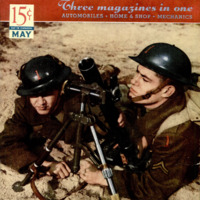 Popular Science Monthly, v. 138, n. 5, 1941
Popular Science Monthly, v. 138, n. 5, 1941

